Current Nature: One Island, Countless Species: Nantucket BioBlitz 2025
Ajay Devendran, Linda Loring Nature Foundation •
Is it possible to identify and collect data on thousands of animal and plant species across Nantucket? Are there even that many living organisms on the island? Where do they all exist?
Just a few hours participating in the Linda Loring Nature Foundation and The Nantucket Land and Water Council’s BioBlitz event at the Creeks, led by Dr. Sarah Bois (LLNF), enlightened me to the variety of living organisms that inhabit the island. This beach and salt marsh habitat held more diversity than I could have ever imagined!
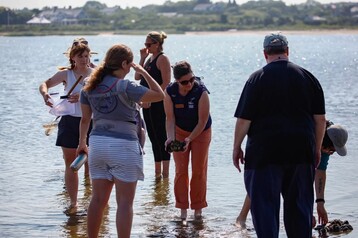
The annual BioBlitz (this year, it runs from July 25th to August 8th) unites the community to document the biodiversity of life on land and in the sea, as well as plants, ecosystems, and more. Everyone, from professionals to longtime residents to new visitors and curious children can participate - all with just a phone. I joined the BioBlitz as a photographer, curious high school student, and summer intern with LLNF (with little prior knowledge of Nantucket’s diverse habitats…), and I learned so much along the way.
As we waded through the cool, shallow water at The Creeks Preserve, Dr. Bois introduced the group to the iNaturalist app. The software allows community members to take a photo of any organism (alive, dead, feces, or even traces), and the app can make an identification of the species, mark its location, and add to the global database of photos. Upon confirmation by other iNaturalist users, the data can be classified as “research grade,” allowing all residents to meaningfully contribute to conservation research on the island. After collecting just a few good pictures in the app, it became addicting, like a treasure hunt!

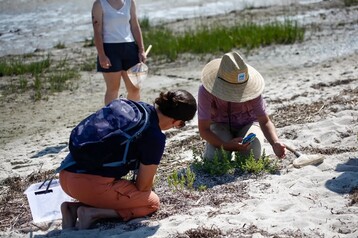
As we searched further, the highlight of the morning was encountering multiple horseshoe crabs buried in the sand. These creatures roam in low tides near beaches and have large, dark, shells and colorful underbellies. Horseshoe crab eggs are a vital food source for other marine life, such as migrating birds. We observed fiddler crabs, mottled sand grasshoppers, and even a nearly complete skeleton of a small creature, presumably a small fish, camouflaged in the sand. The marsh is also home to a wide variety of plants, such as sea lavender and ferns, which thrive beside the Nantucket Harbor. Who knew all these organisms could share the same habitat?
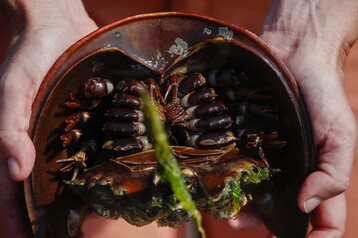
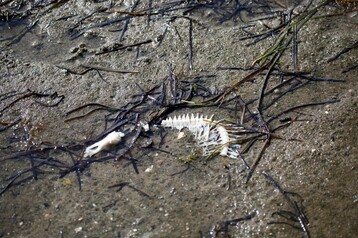
Without the keen eyes and profound knowledge of our guides, much of the diverse life present in the marsh would have gone unseen and unappreciated. I’ll admit that I wouldn’t have spotted 80% of what we saw. However, I learned that details such as small holes in the sand, footprints, and tracks can help spot and identify these sometimes minuscule creatures.
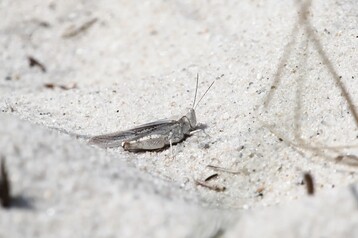
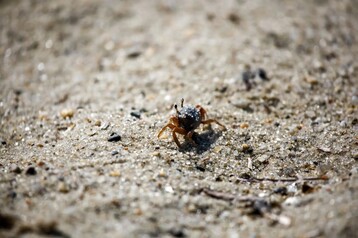
This year’s BioBlitz is only half way gone, and about 480 species have been documented in the first week. With the 2024 BioBlitz having great success - boasting new records of 3,653 observations and 982 species photographed - we hope to see similar numbers for this year. The BioBlitz has two main goals: 1) To allow the community to engage and contribute to conservation of plant and animal species and 2) To add to the Nantucket and global database on iNaturalist.
Dr. Bois explained how fresh data helps scientists observe the health of ecosystems, monitor biodiversity, and detect potential dangers like invasive species. The LLNF and NLWC have already led multiple public “nature rambles” through The Creeks and the LLNF property, and there is more to come this week. The BioBlitz ends on Friday, August 8th, with a wrap up party on the LLNF porch, where BioBlitzers can discuss their findings, results, and share their passion for nature alongside light refreshments.
Everybody can contribute to the Nantucket BioBlitz this year, and it's easier than ever - especially in underexplored areas. You never know what might be found. Last year, we noticed fewer observations in the Tom Nevers area – but this year, we are already seeing an effort being made to document this area. New data, especially in these areas, is crucial to documenting the full scope of the island. Your contributions can make a huge scientific impact, all while discovering the biodiversity around Nantucket. So what’s stopping you from learning about some furry friends, busy birds, and prickly plants while helping to document Nantucket’s ecosystems?
Stay tuned for more editions of Current Nature, a bi-weekly column featuring seasonal topics, natural history information, and advice on the outdoors from the staff at the Linda Loring Nature Foundation.
All photos by Ajay Devendran